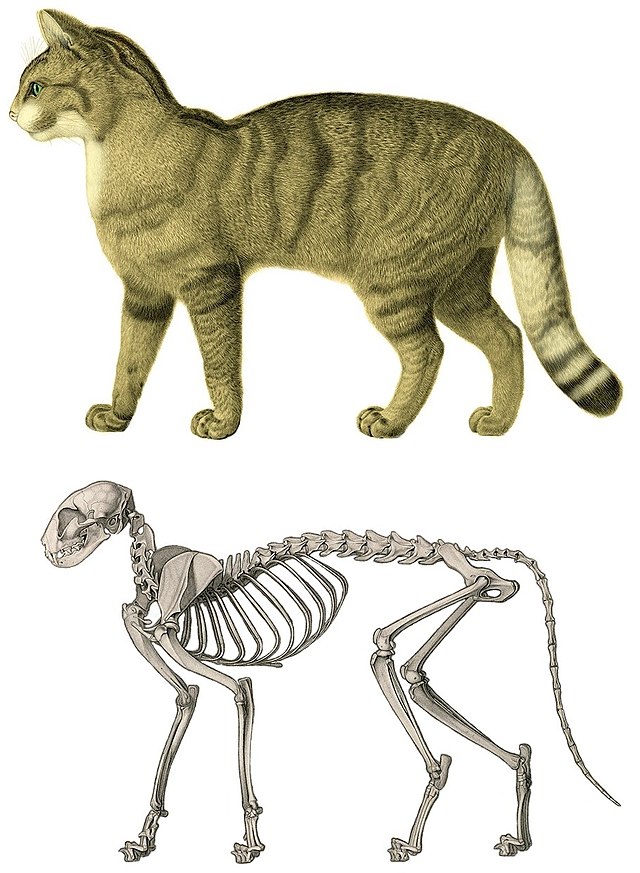Cats are captivating creatures that have been tamed for countless centuries. Their distinctive character, nimbleness, and adeptness at hunting have solidified their position as one of the most beloved companion animals globally. However, a lesser-known aspect of cats is their skeletal composition and physical form.
In this piece, we will delve into the intriguing makeup of a cat’s body and skeleton. We will examine their bones, muscles, and various internal structures that enable them to move with such elegance and accuracy. Without further ado, let us explore the realm of feline anatomy.

The Bones of a Cat’s Skeleton
The Skull
The skull of a cat is composed of several interconnected bones. The orbits, which are highly noticeable, are located at the front of the skull and give the animal the ability to see with both eyes simultaneously. This feature allows for accurate perception of depth and distance, making cats skilled hunters.
The cat’s jaws possess considerable strength, enabling them to clamp down on their prey with significant pressure. Their teeth are distinctly sharp and pointed, aiding in the efficient tearing of flesh and bone. The quantity and placement of their teeth are also distinct from other mammals, totaling 30 in number.
The Vertebrae
The spine of a cat is made up of 7 cervical vertebrae in the neck, 13 thoracic vertebrae in the chest, 7 lumbar vertebrae in the lower back, 3 sacral vertebrae in the pelvic region, and a variable number of coccygeal vertebrae in the tail. This structure provides a lot of flexibility and allows them to contort their bodies into various positions.
A fascinating aspect of a cat’s spinal structure is its remarkable flexibility, which is made possible by the existence of intervertebral discs. These discs serve as protective pads between the vertebrae, effectively absorbing impact and preventing injury when the cat engages in activities like leaping or landing on its paws.
The Limbs
A feline’s appendages are composed of numerous bones joined by joints and ligaments. The forelimbs possess five digits each, whereas the hind limbs have four digits each. Each digit is equipped with a retractable claw that can be hidden within the paw. This characteristic allows for the maintenance of sharp claws and avoids them from being worn down while walking.
Contrary to many other mammals, the feline’s shoulder blades are not directly connected to their structure. Rather, they are linked by muscles, giving the cat the ability to independently move their front limbs. This provides them with exceptional stability and dexterity, allowing them to quickly alter their course and execute graceful movements.
The Muscles of a Cat’s Body

Skeletal Muscles
The tendons of skeletal muscles serve as the connection between muscles and bones, allowing for essential body movements. Cats possess highly resilient skeletal muscles, which give them the ability to effortlessly jump long distances and climb trees.
One distinctive characteristic of cat skeletal muscles is their capacity to utilize anaerobic metabolism for prolonged periods. This enables them to generate energy without requiring oxygen, allowing them to engage in short bursts of high-intensity activity. This makes them highly skilled hunters and sprinters.
Cardiac Muscle
The heart contains cardiac muscle which functions solely in pumping blood to all parts of the body. In comparison to other mammals of similar size, a cat’s heart is relatively compact. Despite its size, it beats at a rapid pace, averaging 160-240 beats per minute while at rest. This quick heart rate enables cats to swiftly provide oxygen to their muscles during physical activity.
Smooth Muscle
Smooth muscle can be found in various parts of the body, including the digestive tract, respiratory system, and blood vessels. It performs involuntary movements like peristalsis and constriction. In cats, smooth muscle in the digestive tract is especially efficient, enabling them to digest meat and other proteins at a rapid pace.
The Organs Inside a Cat’s Body

The Lungs
The respiratory system of felines is comparatively small in relation to their body size, causing them to breathe at a faster pace. They take in oxygen and expel carbon dioxide through their nostrils and mouth. Cats are considered obligate nasal breathers, meaning they depend solely on their noses for respiration.
The Liver
The liver plays a crucial role in numerous essential functions within the body, such as eliminating harmful substances from the bloodstream and generating bile. In comparison to other animals of similar dimensions, felines possess a relatively substantial liver, enabling them to efficiently break down proteins and process fat.
The Kidneys
The kidneys play a crucial role in removing waste substances from the blood and maintaining proper fluid levels within the body. Cats have exceptionally efficient kidneys that are able to retain water, enabling them to thrive in dry conditions. Additionally, their kidneys possess a distinctive capability to concentrate urine, facilitating the expulsion of waste in a concentrated form.
Conclusion
The structure and form of a cat’s bones is undeniably intriguing, providing insight into their remarkable hunting abilities. Every aspect of their physical makeup, such as their flexible spine and strong muscles, is precisely adapted for survival in their environment. Through understanding the unique traits of feline anatomy, we can develop a deeper appreciation for these exceptional creatures.
